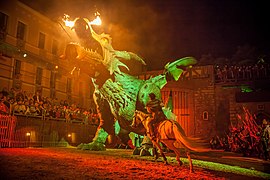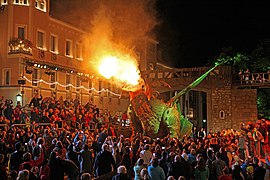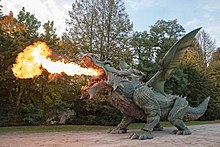Further Drachenstich
| Further Drachenstich | |
|---|---|
|
Intangible cultural heritage |
|

|
|
| The dragon sting game crowd |
|
| State (s): |
|
| List: | National list |
| Weblink: | unesco.de |
| Admission: | 2018 |
The Drachenstich in Furth im Wald in the Upper Palatinate is considered the oldest popular play in Germany. As Drachenstich this killing is generally a dragon called. The name is widespread locally in many regions in southern Germany and Austria with regional dragon sagas. The drama was included in the nationwide directory of intangible cultural heritage in 2018 .
history
Originally the Drachenstich in Furth im Wald part of the Corpus Christi - procession . A message has been received from the year 1590 that a citizen in armor walked with the “handling” of the procession . It can be assumed that the "fight of good against evil", as we experience it in the story of the popular Saint George , was the model for this tradition.
The connection between the Corpus Christi procession and folk customs led to criticism from the church and the authorities several times over the years. The reference to the poverty of the people on the border, that the dragon sting attracted “a lot of people” from both sides of the border, was an important economic reason. Finally, in 1887, the dragon stitch was scheduled for a summer date, and the Corpus Christi procession had to "do without" the dragon. For this purpose, a large historical pageant was installed and a festival in which the eternal struggle of good against evil was integrated into a play.
In 1951 Josef Martin Bauer wrote a new version of the play about the killing of the dragon, which now depicts the Hussite Wars as a historical background and takes place in 1431. In this version, the dragon becomes a symbol of the horrors of war in the border region around Furth. The hero and dragon slayer is the standard bearer Udo, who saves his castle wife Maria ("The Knight").
In 2006, alongside the old play by Josef Martin Bauer, a new version penned by the director Alexander Etzel-Ragusa premiered. Since 2007 only the new version has been performed. The new piece is supposed to pay tribute to the political development (collapse of the Eastern bloc) and to give more space to the characters and the story at the time of the Hussite Wars.
Performances
The spectacle is performed every year in Furth in several performances during the festival week, which traditionally begins in August each year. With well over a thousand participants in original costumes and over 250 horses, the parade is a main event in which the history of the city is presented from the first documented mention (1086) to the 18th century. In addition to the drama and the pageant, other festivals have now been grouped around the event. A folk festival, as well as the historical camp and tournament “ Cave Gladium ” and a children's festival . The history of the dragon stitch and the dragon can be found in the 1st German Dragon Museum and in the Dragon Cave.
In 2000, the dragon sting was performed by the Further actors at the Bavarian Festival in Regensburg . This festival was the highlight of the official Bavarian events at the turn of the millennium with participants from all over the Free State.
gallery
Scenes of the Further Drachenstich
Tradinno (Fanny)
On July 15, 2006, it was announced that funding for a new kite had been secured. In nine years of planning and construction, a 15.5 meter long, 3.8 meter wide, 4.5 meter high and 11 ton heavy walking robot was built at Zollner Elektronik in Zandt . The cost was 2.3 million euros. He was received on July 2, 2010 in Furth. Around 10,000 people watched the transport with a heavy-duty truck from Zandt to Furth im Wald. The kite can walk up to 1.8 kilometers per hour, lift and turn its head, has facial expressions, a flexible tail, can spread its wings up to 12 meters, spit fire and smoke 5 meters and roar. It has been used at the festival since July 31, 2010. The new dragon is currently the world's largest robot on four legs and was included in the Guinness Book of Records in 2012. The project title for the construction of the new Further kite was Tradinno (TRADition + INNOvation). The Further lovingly call him "Fanny".
Others
The German Post AG brought to more than 500-year anniversary of the Dragon slaying Further on August 9, 2001, a special stamp worth 1 DM out.
Web links
- Official homepage of the Drachenstich Festival
- Alexander Schöppner : The Drachenstich zu Furth im Wald In der Oberpfalz in the Gutenberg-DE project
- Official website of the Further Dragon
- Information on br .de
- News about the Drachenstich
Individual evidence
- ↑ a b Further Drachenstich , on unesco.de
- ↑ a b The Zollner Group develops and implements the world's largest four-legged walking robot , accessed on November 13, 2017
- ↑ Largest four-legged walking robot in the world , accessed on November 13, 2017
- ↑ Wolfgang Baumgartner: "Fanny" dresses up for her trip. Mittelbayerische.de, April 5, 2017, accessed on August 16, 2017 .
Coordinates: 49 ° 18 ′ 29.7 ″ N , 12 ° 50 ′ 39.1 ″ E





